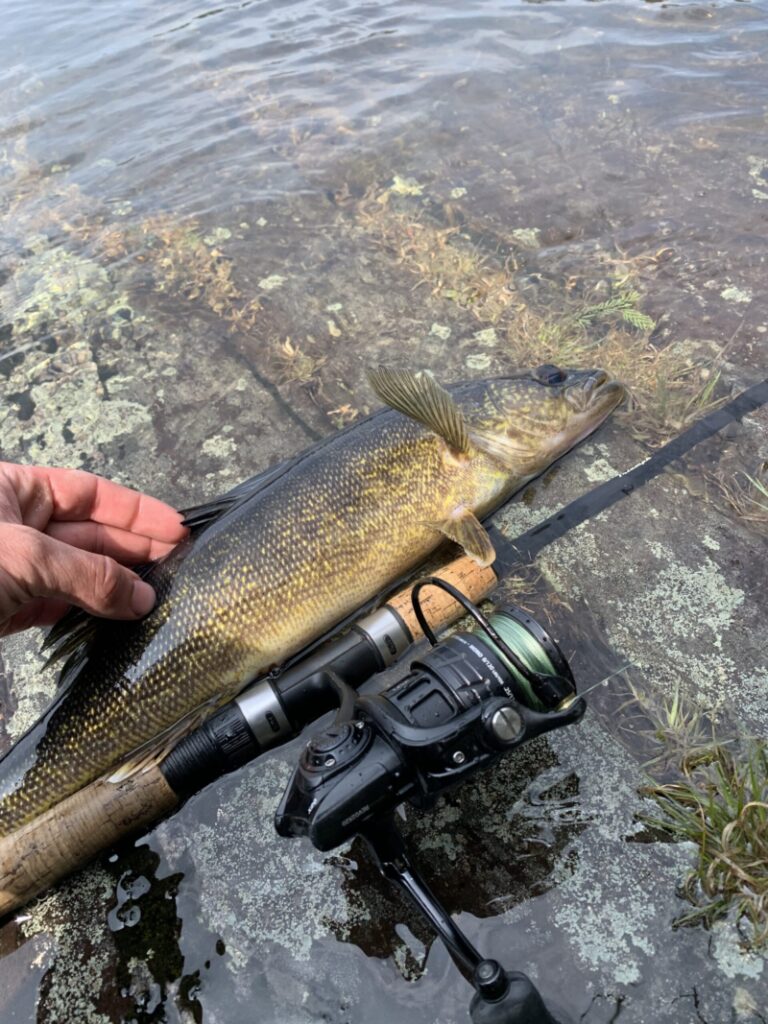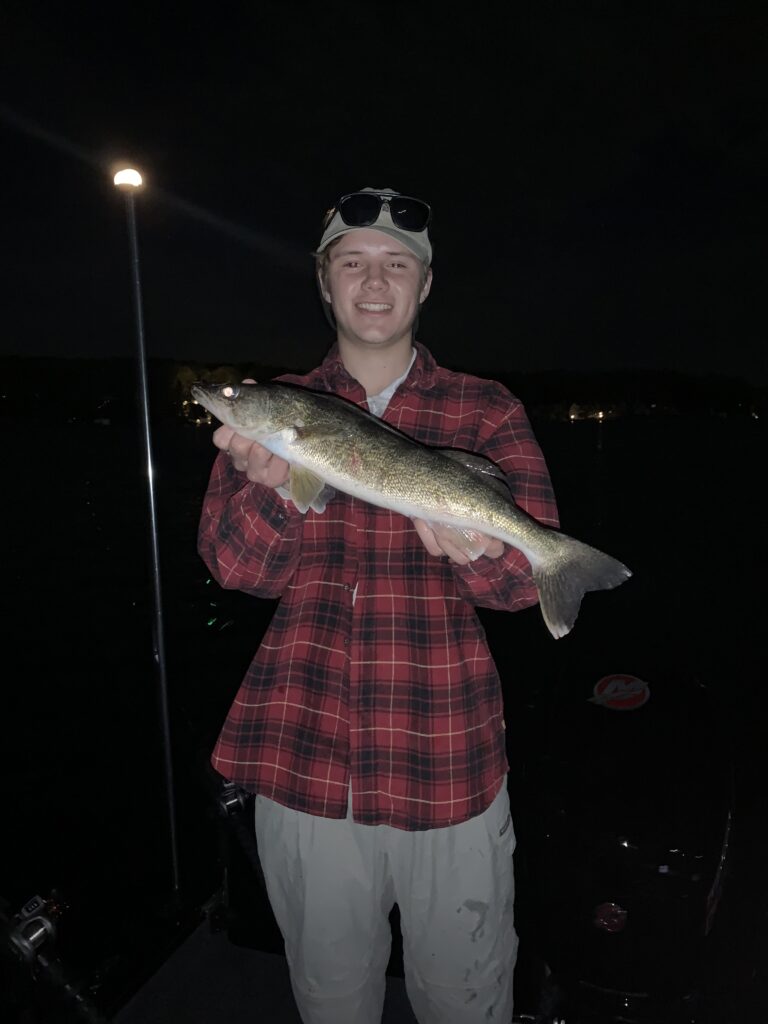Are you ready to take your walleye fishing to the next level? Well, get ready to revolutionize your fishing game with some topwater walleye fishing techniques. I know this goes against almost everything we thought we knew about walleye fishing and sounds crazy to most walleye anglers. I’m here to tell you that walleye will in fact hit on topwater and you can put the odds in your favor with a few tips from this article. As a young and passionate fisherman myself, I’ve discovered the sheer excitement that comes with a nighttime walleye strike on the water’s surface. Trust me, it’s an experience you won’t want to miss!
As always, fishing education and conservation are our priorities here at The Angler’s Line. Feel free to sign up for our free newsletter to join our community and stay up to date! Lets get started!
Table of Contents:
- Walleye Behavior and Habitat
- Topwater Lures For Walleye
- Keys to Success
- Topwater Locations For Walleye
- Tackle and Gear for Topwater Fishing
- Conservation
Understanding Walleye Behavior and Habitat
Before we dive into the exciting world of topwater walleye fishing, it’s important to have an idea of where to start your search. Walleye prefer points, steep breaks, and humps in close proximity to deep water. These pieces of structure tend to be even better for walleye if you can locate weed beds, submergent wood, or rocks on top of them. Be up to date on seasonal walleye movements, as their location constantly changes. Follow the bait and you are sure to find walleye nearby.
When it comes to topwater walleye fishing, it’s essential to understand the walleye’s feeding patterns. Typically, they’re known to be more active during low-light conditions. Prime time for walleye fishing is typically dawn and dusk, but it can extend into the night as well. This is more true than ever when fishing topwater for walleye. Your chances of success will be much higher when the sun has set.
Exploring Topwater Lures for Walleye
Now that we have a grasp of walleye behavior, let’s dive into the world of topwater lures and baits for walleye fishing. There are various options to choose from, each with its own unique characteristics that can trigger a walleye’s predatory instincts.
Poppers
One of the most popular techniques for topwater walleye fishing is “popping and chugging.” This involves using a popper which has a concave face that creates a popping sound and commotion on the water’s surface. The popper is a lure that is meant to be worked slowly. Give the bait a pop with your rod tip and then let it sit still and allow the ripples to dissipate before popping it again.

Walking Baits
Another effective technique is the “walk-the-dog” retrieve for walleye. This involves using a walking style topwater lure which creates a side-to-side motion across the water’s surface. This retrieve takes a little practice to master. Use constant downward twitches of the rod tip to achieve the correct action. Make sure to time your twitches accordingly. The erratic movement mimics a wounded baitfish, triggering aggressive strikes from walleye.
Buzzbaits
Buzzbaits can also work wonders when it comes to topwater walleye fishing. Typically popular in the bass fishing community, buzzbaits can also work wonders for aggresive walleye. These lures feature a propeller that creates vibration and surface disturbance. Combine that with a buzzbait trailer of your choice and you have a recipe for success! In order to get the proper action from a buzzbait, keep your rod tip up and reel in quickly. Due to the fast nature of this technique, I recommend using it when night fishing for walleye during the summer months.
Original Floating Rapala
I know this isn’t truly topwater, but the original floating Rapala has been catching walleye for ages. The Original Floating Rapala only dives a few feet deep on a steady retrieve and floats to the surface on the pause. My favorite way to fish this lure is a twitch and pause technique for walleyes near the surface in the spring months.
Topwater Walleye Fishing: Keys To Success
Now that we’ve covered the different types of lures, let’s dive into some important considerations to make when it comes to topwater walleye fishing.
When Is The Best Time To Fish Walleye on Topwater?
The time of year and time of day is crucial when it comes to topwater walleye fishing. As mentioned earlier, walleye tend to be more active during low-light conditions and more susceptible to hit surface lures. However, you don’t always have to limit yourself to fishing at dawn or dusk. On cloudy days with low pressure or when fishing in stained water, walleye may still be willing to strike on the surface even during daylight hours. On clear bodies of water, I have found that the topwater walleye bite can extend well into nighttime as well, not just at sunset. Experimentation is the key to finding what works best in your fishing spot.
Adjusting Techniques
Remember, each day on the water can be different, so don’t be afraid to adjust your techniques accordingly for topwater walleye fishing. If you’re not getting any action, try varying the speed, cadence, or pause length during your retrieves. When topwater fishing, it is critical to be constantly adapting and letting the walleye tell you what they want. Sometimes a subtle tweak or lure change can make all the difference.
Be Concious of Noise
To maximize your success with topwater walleye fishing, try using a stealthy approach. Approach your fishing spot quietly and cast your lure out as far as possible. Walleye can be easily spooked, so minimizing noise and disturbances is crucial.
Topwater Locations For Walleye
To increase your chances of success with topwater walleye fishing, it’s important to have a good understanding of which locations are best to target.

Fish The Flats
Fishing the flats is probably the best piece of advice I can give you when it comes to fishing for walleye with topwater lures. Walleye move up from deep water and on to flats to actively feed on bait. Since topwater is an aggressive technique, use this to your advantage by targeting areas where aggressive and actively feeding walleye are most likely to be.
When trying to determine which flats are best to target, I focus on finding structure and cover nearby. Flats with rocks, vegetation, or submergent wood are great places to start. Additionally, look for flats that are in close proximity to deep water. In the summer, walleye will stay in deep water throughout the day and then slide up shallow during low-light periods. Walleye like locations where they can slide from shallow to deep quickly.
Tackle and Gear Considerations
Now let’s talk about the essential tackle and gear you’ll need for topwater walleye fishing.

The Right Rod and Reel
I recommend choosing a medium-light or medium power rod for topwater walleye fishing. Most topwater lures have treble hooks, so having a light rod is important to keeping the hooks pinned. Pair your rod with a quality spinning reel of your choice that provides smooth drag. Topwater is a great technique for using a baitcaster for walleye as well. Keep in mind that baitcasting reels are not as beginner friendly as spinning reels and require more practice.
Best Line For Topwater Fishing
Opt for either a braided or monofilament line. Braided line and monofilament line float, and fluorocarbon line sinks. You’ll definetely want a line that floats for fishing topwater. For braided line, use between a 10lb-20lb test for walleye. For monofilament, I recommend between 8-12lb.
Conservation and Ethical Fishing Practices
As responsible anglers, it’s crucial to prioritize conservation and practice ethical fishing. Adhere to catch-and-release guidelines whenever possible to preserve the walleye population for future generations. Handle fish with care, use barbless hooks to minimize injury, and return them to the water as quickly and gently as possible. Respect fish and wildlife habitats by minimizing your impact and leaving the environment as pristine as you found it.
Congratulations, fellow anglers! Hopefully now you have learned about how to fish topwater for walleye. Remember to consider the behavior and feeding habits of walleye when selecting the right location and lure for each situation. So get out there, explore new fishing spots, and enjoy the exhilarating moments when walleye explode on your topwater lures. Happy fishing, and may your next topwater walleye fishing adventure be unforgettable!
